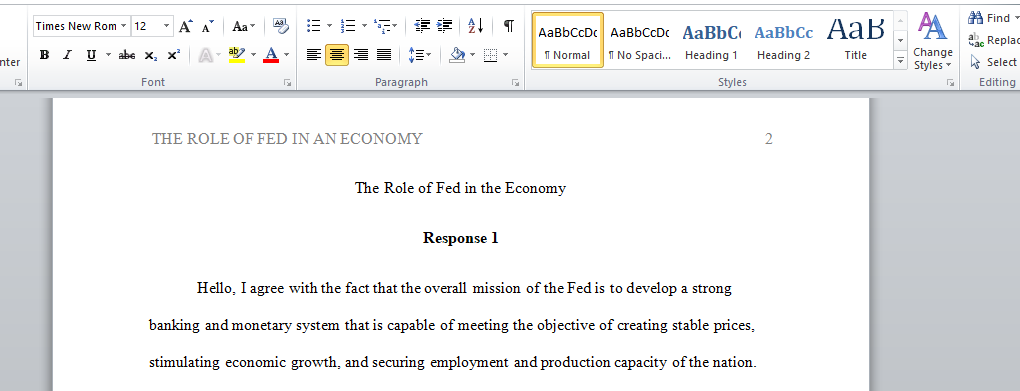What is the mission, or goals, of the Fed?
Watch the attached video then click on the above link “The Fed ” and create a thread with at least one page answering and explaining the following
#1:
The Fed is the central bank of the U.S and its mission is to establish and maintain public confidence in the nation’s monetary and banking system. The Fed’s main goal is to have a stable economy characterized by higher employment and production, steady growth, and overall stable prices. The Fed is a decentralized central bank and consists of two parts: A board of governors as well as 12 regional reserve banks. The Fed operates independently within the government but is not independent. The board of governors represents the governmental side (public sector) of the Fed while the 12 reserve banks represent the public sector. Having these two sides of the Fed allow for accountability and helps the Fed stays away from centralized government control. Printing money indefinitely causes an increase in demand, which will then lead to inflation. The Feds purchase securities like U.S treasuries in order to help stabilize the nation’s supply of money and credit. If the Fed states that there is too much money they will sell securities. However, if there is too little money then the Fed will buy securities. The Fed has the responsibility that rules given by Congress are followed in order to ensure the security of banks which in turn builds trust. The Fed monitors banks and bank holder companies and looks at things such as financial records or if the bank is following laws. The bank will then receive a rating and if a problem is detected, the Feds will require the bank to take immediate action. The Fed is often referred to as the “Bankers Bank” because they play a role in transferring funds from one bank to another. The Fed also plays a role as the bank for the U.S and is responsible for many things like issuing, servicing, and redeeming treasury securities. The Fed must make sure there is always enough money in circulation. After watching the present money supply clock, the number kept increasing. It was raised by 1 million in only a few seconds, which means that as the money supply increases, the prices of goods will also increase eventually causing inflation.
#2:
The mission and ultimate goal of the “Fed” is to establish and maintain the public confidence and ultimate security of our nations monetary and banking system. The tasks also grew to balancing the economy and making sure the money flow is intact as well. The Fed is known as a decentralized central government. What this means is that it is made up of a private and public sector. The public sector consists of the Board of Governors which is appointed by the President of the United States, and thus being approved by Senate. There are 12 regional Federal reserve banks in the United States that help regulate the states banks and for funding purposes. The Fed is Independent but within the governments jurisdiction. These federal reserve banks make up the private sector. So, essentially there are two different parts of the Fed. The main reason why there is not an abundance of federal reserve notes or “money” floating around is because having too much money creates inflation. The Fed regulates and supervises banks within the use of their private and public sector and its importance is that it helps keep the economy in check and not and abundance of money or too much goods for sale. Some services that the Fed provides is that it establishes and implements monetary policy, regulates and supervises banks, and operates the payments system and that is where the the term “Banker’s Bank” is utilized. Under circumstances such as having too little money circulation, the federal reserve will buy securities as such as U.S. treasury to even out the economy. The category in M2 on the website “US Debt Clocks” shows a increase in the money supply that is overall pretty good for the economy but it may decrease eventually.
- What is the mission, or goals, of the Fed?
- Explain the structure of the Fed and the hierarchy of governance.
- Is the Fed a public or private entity? Who owns the Fed?
- If issuing Federal Reserve Notes stimulates the economy, why not print money indefinitely?
- Under what conditions would the Fed purchase securities like U.S. treasuries?
- How does the Fed regulate and supervise banks and why is this important?
- What services does the Fed provide to our country’s financial system and how did it come to be known as the “Bankers Bank”?
- Visit the debt clock website at http://www.usdebtclock.org/
(Links to an external site.) and locate the category M2. This is the present money supply in the hands of the public. Using a timer determine how much the money changes in 1 minute. Is it increasing or decreasing? What do you think this means for the overall economy? - After you post your narrative, reply to at least two other students comments. Explain why you agree, or better yet, find others that take a different position and explain why you disagree
Answer preview:

Wotds:289
